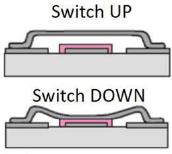George Palasantzas receives funding from NWO Open Technology Programme
Professor George Palasantzas of the Zernike Institute for Advanced Materials (ZIAM) receives funding from the NWO Open Technology Programme (OTP). He receives the grant for the project 'Repulsive Casimir forces from topological insulators towards device actuation'. A total of six technical-scientific research projects have received funding.
The Open Technology Programme offers funding for excellent and application-oriented technical-scientific research. The programme allows companies and other organizations to connect with scientific research in an accessible way. These collaborations should lead to applicable knowledge.

‘Repulsive Casimir forces from topological insulators towards device actuation’
A topological insulator is a material that behaves internally like an insulator, but whose surface contains conducting states. Because of the unique properties of these surface states, topological insulator materials can potentially open new opportunities for the actuation of future micro/nanoelectromechanical systems. But, such an application must take into account the omnipresent Casimir force, which will drive two electrically neutrally charged metal plates together in a nanoscale vacuum. This can have a sticky effect called stiction, making it impossible to shift the surfaces relative to each other.
Hence, a natural question to ask is how the Casimir force would manifest itself in these novel materials as they interact with each other and other materials that are present in operating systems. So far, the Casimir force has been predicted only theoretically to become repulsive by controlling the sign of the topological magnetoelectric polarizability and the distance between the interacting TI surfaces in the separating ranges 100 nm. Palasantzas aims to experimentally demonstrate these repulsive Casimir forces and explore its effect on stiction phenomena during the actuation of micro/nanodevices.
| Last modified: | 05 July 2022 10.59 a.m. |
More news
-
29 April 2024
Tactile sensors
Every two weeks, UG Makers puts the spotlight on a researcher who has created something tangible, ranging from homemade measuring equipment for academic research to small or larger products that can change our daily lives. That is how UG...
-
29 April 2024
Behind the scenes: how UG and Hanze UAS students are jointly developing a Mars rover
This year the students of the Makercie team are participating in the physical edition of the European Rover Challenge in Poland. Read more about the team and the collaboration between the RUG and Hanze UAS here.
-
23 April 2024
Nine MSCA Doctoral Network grants for FSE researchers
Nine researchers of the Faculty of Science and Engineering have received a Horizon Europe Marie Sklodowska Curie Doctoral Network grant.
